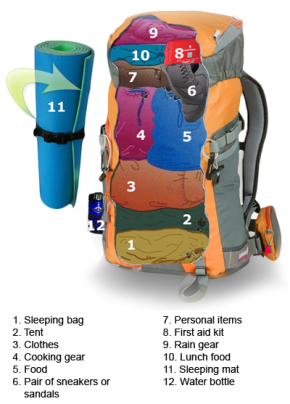Preparing for outdoor trip
Hiking on uneven ground or climbing and descending long inclines is more physically demanding, than walking on pavement, especially while wearing hiking clothing and boots, and carrying a backpack. To prepare adequately, you need to try out your gear and get your body in shape.
Some useful tips for those of you who are getting ready for the first hiking experience:
Conditioning your body for hiking. Get ready physically and mentally for your trip! Know your body’s abilities and physical limitations; choose an appropriate hike. Your pre-hike training should include both aerobic exercise and weight training (look for exercises, that work the quads, thighs and hamstrings), as well as stretches for your leg, arm and back muscles.
Test your gear and clothing. Prevent equipment problems by ensuring that it is in good condition. Check your equipment before you go and be sure, that old gear is still functional and new gear, especially boots, fits properly and is broken in.
Try your clothing on. Note the weather expected on your hike, whether the clothes, you are wearing, will be comfortable at specific temperatures and conditions.
Break in your hiking boots. Wear your boots around the house to double check they fit before breaking them in. Go on short hikes to soften your boots and toughen your feet. Walk on uneven ground, that forces your feet to bend in different directions. But be sure to take blister treatment along just in case your boots still rub. To prevent blisters you can also apply a tape on commonly potential blister spots (the back of the heel, side of foot, toes) before you start your hike.
Pack your backpack. There are few important principles you should keep in mind when packing your backpack. It should be well organized, comfortable, and water protected. Here are some recommendations about how to pack your backpack:
Keep items you might need during the day handy. Water, lunch food, raingear, maps, flashlight, pocketknife, first-aid kit, extra shoes, pack cover, and other emergency supplies all go in external pockets or try to put them on upper side of your backpack. Clothes go deep inside. Sleeping bag inside lowest compartment. Depending on the configuration of your pack and the weather, the tent can go inside or outside. Same with sleeping pad, you can strapp it on outside or just roll it and stuff into the pack body.
Heavier supplies as food and cooking gear try to keep as close to your back as possible. It’s more comfortable to carry a backpack when the weight is in line with your body. Remember! The heavier your backpack is – more difficult to hike with it. Your pack weight basically shouldn’t be heavier than 1/4 of your body weight.
Try to keep all gear well protected from water and moisture. In addition to pack cover use waterproof stuff sacks or just trash bags especially for your clothes, sleeping bag and food.

